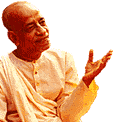Chapter 5: Karma-yoga-Action in Krsna Consciousness
Bg 5.11
TEXT 11
kayena manasa buddhya
kevalair indriyair api
yoginah karma kurvanti
sangam tyaktvatma-suddhaye
kevalair indriyair api
yoginah karma kurvanti
sangam tyaktvatma-suddhaye
SYNONYMS
kayena—with the body; manasa—with the mind; buddhya—with the intelligence; kevalaih—purified; indriyaih—with the senses; api—even with; yoginah—the Krsna conscious persons; karma—actions; kurvanti—they act; sangam—attachment; tyaktva—giving up; atma—self; suddhaye—for the purpose of purification.
TRANSLATION
The yogis, abandoning attachment, act with body, mind, intelligence, and even with the senses, only for the purpose of purification.
PURPORT
By acting in Krsna consciousness for the satisfaction of the senses of Krsna, any action, whether of the body, mind, intelligence or even of the senses, is purified of material contamination. There are no material reactions resulting from the activities of a Krsna conscious person. Therefore, purified activities, which are generally called sadacara, can be easily performed by acting in Krsna consciousness. Sri Rupa Gosvami in his Bhakti-rasamrta-sindhu describes this as follows:
iha yasya harer dasye karmana manasa gira
nikhilasv apy avasthasu jivanmuktah sa ucyate
nikhilasv apy avasthasu jivanmuktah sa ucyate
A person acting in Krsna consciousness (or, in other words, in the service of Krsna) with his body, mind, intelligence and words is a liberated person even within the material world, although he may be engaged in many so-called material activities. He has no false ego, nor does he believe that he is this material body, nor that he possesses the body. He knows that he is not this body and that this body does not belong to him. He himself belongs to Krsna, and the body too belongs to Krsna. When he applies everything produced of the body, mind, intelligence, words, life, wealth, etc.—whatever he may have within his possession—to Krsna's service, he is at once dovetailed with Krsna. He is one with Krsna and is devoid of the false ego that leads one to believe that he is the body, etc. This is the perfect stage of Krsna consciousness.
Copyright (c) 1972 by His Divine Grace A.C. Bhaktivedanta Swami Prabhupada










